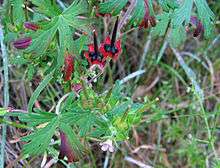Geranium carolinianum
| Geranium carolinianum | |
|---|---|
 | |
| Scientific classification | |
| Kingdom: | Plantae |
| (unranked): | Angiosperms |
| (unranked): | Eudicots |
| (unranked): | Rosids |
| Order: | Geraniales |
| Family: | Geraniaceae |
| Genus: | Geranium |
| Species: | G. carolinianum |
| Binomial name | |
| Geranium carolinianum L. | |
Geranium carolinianum is a species of geranium known by the common name Carolina crane's-bill,[1] or Carolina geranium.[2] It is native to North America, where it is widespread and grows in many types of habitat. This is an annual herb reaching just over half a meter in maximum height. It has erect stems covered in spiky hairs. The palmate leaves are several centimeters wide and divided into usually five segments which are each subdivided into elegantly pointed lobes. The inflorescence is a cluster of one to several small flowers. Each flower has five pointed sepals and five notched petals in shades of white to lavender. The fruit has a hairy body and a style up to 1.5 centimeters long.
Wildlife use
Noted visitors for nectar include long-tongued bees (Megachile spp.), short-tongued bees (Halictid), and flower flies (Syrphid) whom in the larval stage can be early cool season aphid control. Mourning Doves have been observed eating the seeds.
References
- ↑ "BSBI List 2007". Botanical Society of Britain and Ireland. Archived from the original (xls) on 2015-01-25. Retrieved 2014-10-17.
- ↑ "Geranium carolinianum". Natural Resources Conservation Service PLANTS Database. USDA. Retrieved 19 January 2016.